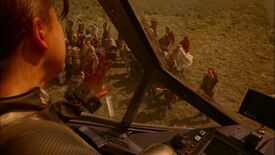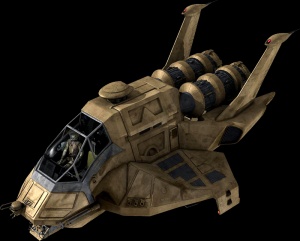Raptor
More languages
More actions
| Raptor | |||
|---|---|---|---|

| |||
| [show/hide spoilers] Spoilers hidden in infobox by default only. | |||
| Race: | Colonial | ||
| Type: | Military | ||
| FTL: | Yes (short range) | ||
| Propulsion: | |||
| Crew: | 2 (Pilot and ECO) | ||
| Capacity: | Approximately 5-10 passengers | ||
| CO: | {{{co}}} | ||
| XO: | {{{xo}}} | ||
| Role: | Reconnaissance and surveillance, electronic countermeasures support, transport | ||
| Weapons: | Missiles | ||
| Armaments: | {{{arm}}} | ||
| Defenses: | {{{def}}} | ||
| Aircraft: | {{{aircraft}}} | ||
| Aviation facilities: | {{{facilities}}} | ||
| Emblem: | [[File:{{{patch}}}|175px|Ship's patch]] | ||
| Other Images: | Gallery | ||
| Length: | 28 feet | ||
| Width: | {{{width}}} | ||
| Height: | 9.5 feet | ||
| Weight: | 50 tons (Miniseries) | ||
| Wingspan: | 18.34 feet | ||
| Other: | {{{otherdi}}} | ||
| Cost: | {{{construction}}} | ||
| Construction Time: | {{{construction}}} | ||
| Hull Size: | {{{hull size}}} | ||
| Hull: | {{{hull}}} | ||
| FTL Cooldown: | {{{ftl cooldown}}} turns | ||
| Speed: | {{{speed}}} m/s | ||
| Turn Rate: | {{{turn rate}}}°/turn | ||
| Armor Total: | {{{armor total}}} | ||
| Armor Left: | {{{armor left}}} | ||
| Armor Right: | {{{armor right}}} | ||
| Armor Front: | {{{armor front}}} | ||
| Armor Rear: | {{{armor rear}}} | ||
| Armor Top: | {{{armor top}}} | ||
| Armor Bottom: | {{{armor bottom}}} | ||
| DRADIS Range: | {{{dradis range}}} m | ||
| Processing Power: | {{{processing power}}} | ||
| Munition Slots: | {{{munitions}}} | ||
| Munition Cooldown Period: | {{{munition cooldown}}} turns | ||
| Squadron Slots: | {{{squadrons}}} | ||
| Squadron Size: | {{{squadron size}}} | ||
| Special Abilities: | {{{special abilities}}} | ||
| Additional Information | |||
Overview
The Raptor is a multi-role vehicle used by the Colonial Fleet. It is generally operated by a crew of two, is capable of atmospheric flight and is also equipped with a short-range Jump engine, allowing it to make short faster-than-light hops.
The Raptor is designed to fulfill a number of roles, the primary being that of reconnaissance / scout operations. Additionally, the Raptor can also undertake the following roles:
- Airborne Warning & Control and Electronic Counter-Measures platform supporting Viper operations (Miniseries, 33)
- Marine assault carrier ("Bastille Day", "Kobol's Last Gleaming, Part II", "Pegasus")
- Ambulance / evac vehicle (Miniseries)
- General purpose transport ("Flesh and Bone", "Tigh Me Up, Tigh Me Down", "Home, Part II")
As an ECM platform, the Raptor contains a full suite of electronic countermeasure and monitoring tools, enabling it to:
- Jam transmissions from other spacecraft (Miniseries, 33)
- Scramble control signals used by guided weapons (Miniseries)
- Undertake IFF operations for Viper squadrons (Miniseries)
In the role of a scout, the Raptor can operate independently of, or in concert with, other Raptors and Vipers (The Hand of God) and:
- Undertake short and medium-range scans to detect radio, heat or other signatures from other vessels
- Scan planetary surfaces for signs of life, energy output, or to assess mineral or other content / location (Water, The Hand of God)
- Scout ahead of its parent warship, scouting star systems, etc., to look for any signs of hostile intent, etc., prior to the parent ship jumping-in (Miniseries)
- Undertake search & rescue operations.
As a transport vehicle, a Raptor is capable of carrying around 8-10 adults in addition to the 2-person crew. As a marine assault vehicle, it can carry a squad of some eight marines plus their equipment (Bastille Day).
Due to its size, the Raptor is not launched via a battlerstar's launch tube; instead it is launched from the forward end of a flight pod.
Typically, a battlestar operates with a single squadron of 8-10 Raptors: 1 Raptor assigned to each operational Viper squadron aboard the battlestar, and potentially two "reserve" Raptors.
Atmospheric Operations
The Raptor is designed for atmospheric as well as space-based operations. However, a critical element to atmospheric operations is that to remain airborne is fuel: once in an atmosphere, the engines must be run constantly to retain lift surfaces. Depending on the composition of the atmosphere itself, this can place severe strain on the Raptor's engines (You Can't Go Home Again).
Due to their overall configuration and bulk, Raptors may also suffer from poor handling at low speeds, and rely heavily on directed thrust to remain airborne.
FTL Operations
A Raptor seems to be able to make at least 10, and probably at least 20 FTL jumps before refueling (Lay Down Your Burdens, Part I). It may, however, have been carrying more than a normal amount of fuel for that mission.
Life Support
The main flight deck / cabin of a Raptor is fully pressurised. However, crews operate in flight suits and helmets to help protect them against any hull breach (Miniseries). The cabin can also be depressurized and used in space rescue operations (You Can't Go Home Again).
Technical Specifications

Propulsion
Armament
- Offensive: Normally unarmed as Raptors make for a poor general-purpose fighter. Can be equipped with bombs ("Kobol's Last Gleaming, Part II") or rockets/missiles perhaps similar to those used on Vipers ("Fragged")
- Defensive: Decoy drones, communication drones and flares; reduced electronic signature to avoid detection
Layout
The Raptor is a boxey vehicle built for purpose, not style. The forward section of the vehicle contains the flight deck, with side-by-side seats for the pilot and ECO (who occupies the rear section of the vehicle during normal operations). This opens into the main body of the vehicle, which contains bulkhead-mounted racks of electronics equipment and sensors. A large canopy provides good forward and side visibility for the crew, which is no doubt of considerable benefit during atmospheric flight. A section of this canopy can be jettisoned in an emergency, to allow the crew to eject using the flight deck seats.[citation needed] A large hydraulic door mounted on the port side of the vehicle provides access to the vehicle. In addition, a floor-mounted hatchway provides a further point of egress. This is linked to a skirt that can be extended from the underside of a Raptor, enabling it to dock with other vessels; in the case of an assault, marines can force an entry into a hostile vessel (Bastille Day).
Aft of the pressurised area are the FTL engine and main sublight engines. Winglets on either side of the hull help to give stability during atmospheric manoeuvres and have landing thrusters mounted under them.[citation needed]
Notes
- The Raptor is the vehicle piloted by Lt. Sharon "Boomer" Valerii
- Boomer blames a malfunctioning gimbal for a rough landing in the miniseries.
- The design of the Raptor was based on the US Army's Apache helicopter. Ronald D. Moore thinks of it "as analogous to the Navy's EA-6 Prowler (a variant of the A-6 Intruder popularized in "Flight of the Intruder")."[1]
References
- ↑ RDM Battlestar Blog (backup available on Archive.org) (in English). Retrieved on 18 April 2006.
.
